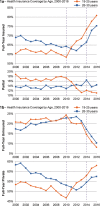Inequalities in Young Adult Health Insurance Coverage Post-federal Health Reform
- PMID: 30430404
- PMCID: PMC6318186
- DOI: 10.1007/s11606-018-4723-0
Inequalities in Young Adult Health Insurance Coverage Post-federal Health Reform
Abstract
Background: Uninsurance for young adults (YAs) was greatly reduced by the Affordable Care Act (ACA). However, reforms may not be equally beneficial for all YAs and certain policies may exacerbate, rather than resolve, pre-existing disparities.
Objective: To investigate inequalities in YAs' insurance coverage pre- (2000-2010) and post-federal health reforms (dependent coverage expansion, 2010-2013, and Medicaid/Marketplace expansions, 2014-2016), among a nationally representative sample.
Design: A difference-in-differences estimator (controlling for sociodemographics) was used to determine the effects of the ACA for young adults (ages 19-25) compared to adolescents (ages 13-18) and older YA (ages 26-30) counterparts; triple-difference estimators quantified differential policy effects by sociodemographics.
Participants: Three hundred eighty-seven thousand six hundred thirty-five participants in the 2000-2016 National Health Interview Survey.
Main measures: Respondents reported their health insurance coverage types during the last 12 months, reasons uninsured, and detailed sociodemographics.
Key results: An adjusted difference-in-differences estimator quantified a 12.3 percentage point increase (p < 0.0001) in full-year coverage post-ACA for YAs compared to older counterparts, driven by increases in employer-sponsored private insurance while younger and older youth saw larger gains in Medicaid coverage. Triple-difference estimators identified subgroups experiencing less beneficial dependent coverage expansion effects, including females, lower socioeconomic status, non-citizens, non-English speakers, and several racial/ethnic minority groups. Later ACA reforms (Marketplace/Medicaid expansions) mitigated many of these widening disparities.
Conclusion: While the ACA significantly impacted YA insurance coverage, these gains were not of equal magnitude for all YAs and disparities remain. As such, more work needs to be done to ensure optimal and equitable access to high-quality, affordable insurance for all YAs.
Keywords: National Health Policy; adolescence; health care disparities; insurance coverage; young adult.
Conflict of interest statement
The authors declare that they do not have a conflict of interest.
Figures




Similar articles
-
Association of Medicaid Expansion With Health Insurance Coverage Among Persons With a Disability.JAMA Netw Open. 2019 Jul 3;2(7):e197136. doi: 10.1001/jamanetworkopen.2019.7136. JAMA Netw Open. 2019. PMID: 31314115 Free PMC article.
-
The three-year impact of the Affordable Care Act on disparities in insurance coverage.Health Serv Res. 2019 Feb;54 Suppl 1(Suppl 1):307-316. doi: 10.1111/1475-6773.13077. Epub 2018 Oct 30. Health Serv Res. 2019. PMID: 30378119 Free PMC article.
-
Has the Affordable Care Act Been Associated with Increased Insurance Coverage and Early-stage Diagnoses of Bone and Soft-tissue Sarcomas in Adults?Clin Orthop Relat Res. 2021 Mar 1;479(3):493-502. doi: 10.1097/CORR.0000000000001438. Clin Orthop Relat Res. 2021. PMID: 32805094 Free PMC article.
-
The Affordable Care Act and access to care across the cancer control continuum: A review at 10 years.CA Cancer J Clin. 2020 May;70(3):165-181. doi: 10.3322/caac.21604. Epub 2020 Mar 23. CA Cancer J Clin. 2020. PMID: 32202312 Review.
-
The ACA Medicaid Expansion And Perinatal Insurance, Health Care Use, And Health Outcomes: A Systematic Review.Health Aff (Millwood). 2022 Jan;41(1):60-68. doi: 10.1377/hlthaff.2021.01150. Health Aff (Millwood). 2022. PMID: 34982621
Cited by
-
Changes in Health Care-Related Financial Burden for US Families With Children Associated With the Affordable Care Act.JAMA Pediatr. 2020 Nov 1;174(11):1032-1040. doi: 10.1001/jamapediatrics.2020.3973. JAMA Pediatr. 2020. PMID: 32986093 Free PMC article.
-
Insurance gaps at age-19 and age-26 health insurance eligibility thresholds by childhood-onset condition severity, Colorado 2014-2018.Health Serv Res. 2025 Apr;60(2):e14432. doi: 10.1111/1475-6773.14432. Epub 2025 Jan 12. Health Serv Res. 2025. PMID: 39800925
-
Child Health Needs and the Pediatric Cardiology Workforce: 2020-2040.Pediatrics. 2024 Feb 1;153(Suppl 2):e2023063678E. doi: 10.1542/peds.2023-063678E. Pediatrics. 2024. PMID: 38300014 Free PMC article.
-
Perceptions, Attitudes, and Experiences Regarding Mental Health Care Among Young Black Men.Am J Mens Health. 2025 Jan-Feb;19(1):15579883241310755. doi: 10.1177/15579883241310755. Am J Mens Health. 2025. PMID: 39930767 Free PMC article.
-
Health insurance among survivors of childhood cancer following Affordable Care Act implementation.J Natl Cancer Inst. 2024 Sep 1;116(9):1466-1478. doi: 10.1093/jnci/djae111. J Natl Cancer Inst. 2024. PMID: 38741226 Free PMC article.
References
-
- Clarke TC, Norris T, Schiller JS. Early release of selected estimates based on data from the 2016 National Health Interview Survey. National Center for Health Statistics; 2017. Available at: https://www.cdc.gov/nchs/data/nhis/earlyrelease/earlyrelease201705.pdf. Accessed 27 Nov 2017.
-
- Majerol M, Newkirk V, Garfield R. The uninsured: a primer – key facts about health insurance and the uninsured in America. Kaiser Family Foundation: Menlo Park; 2015.
Publication types
MeSH terms
Grants and funding
LinkOut - more resources
Full Text Sources
Research Materials

